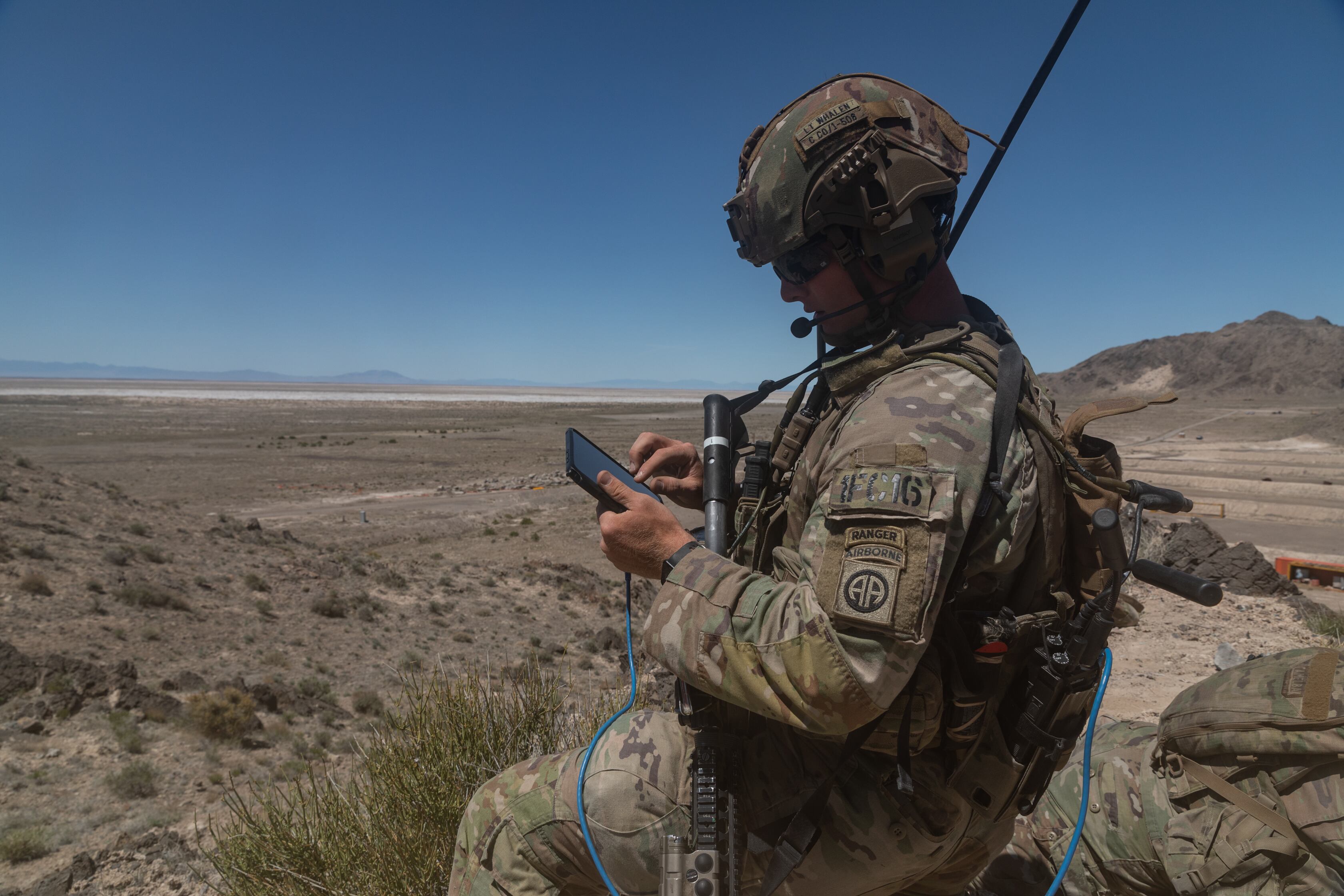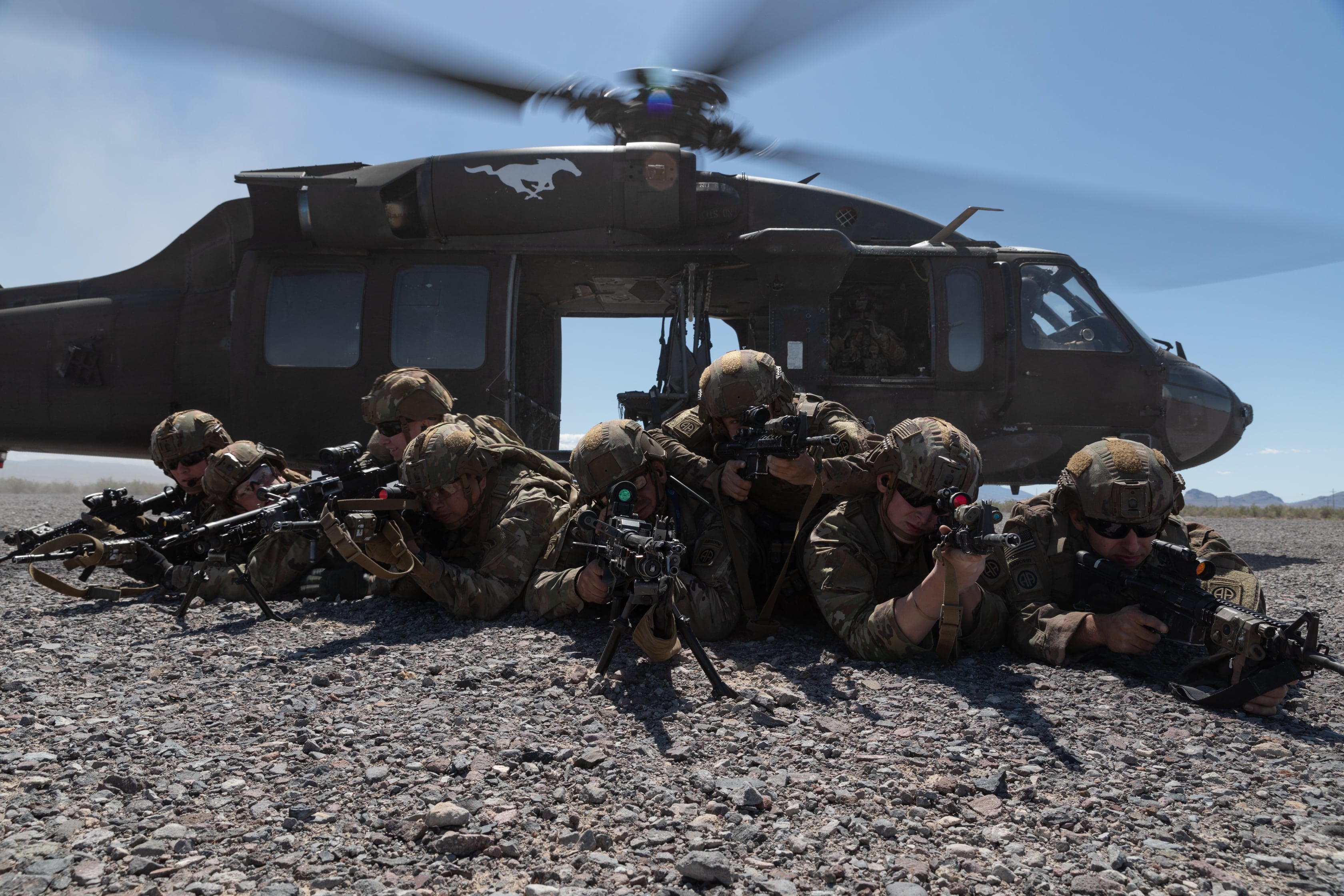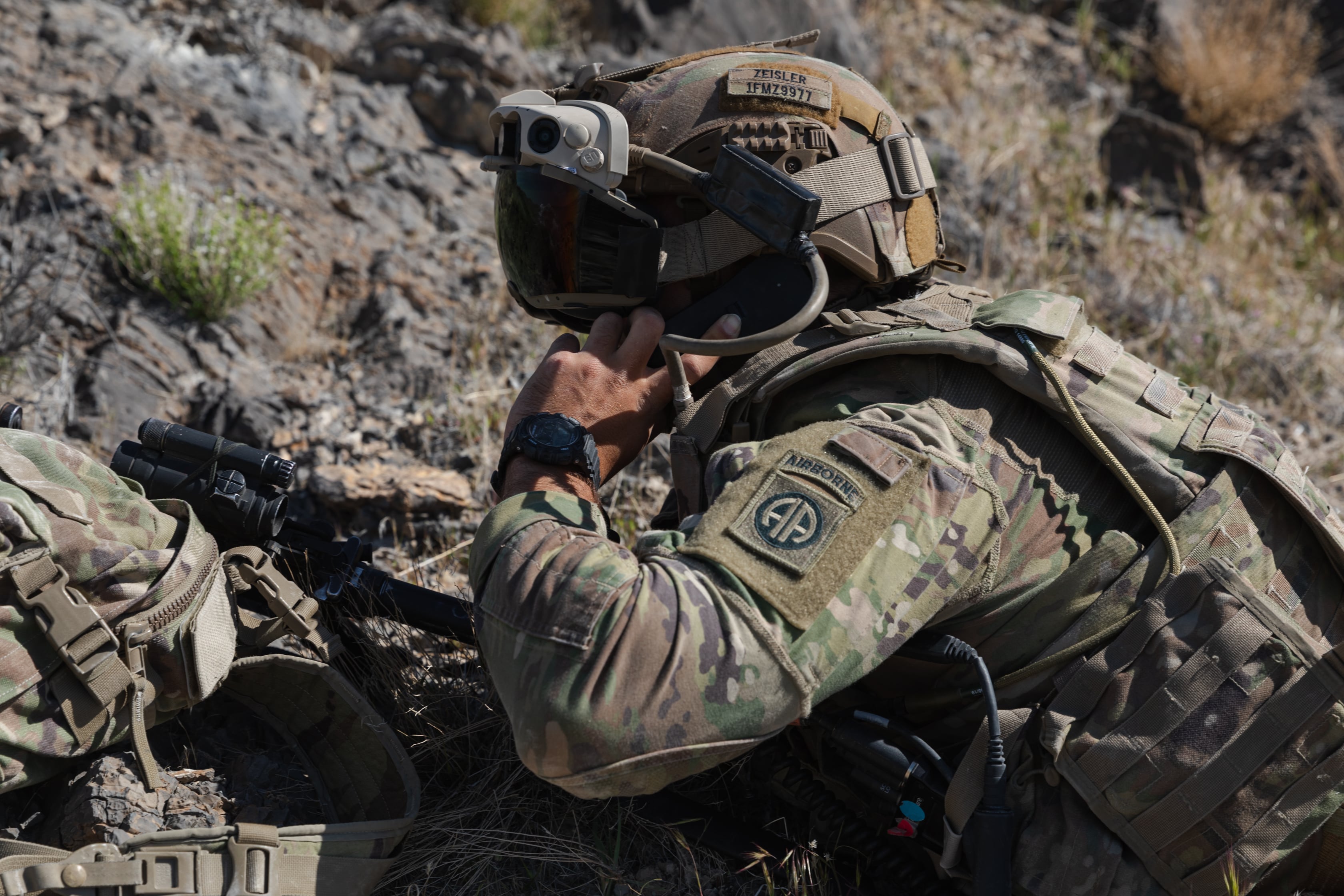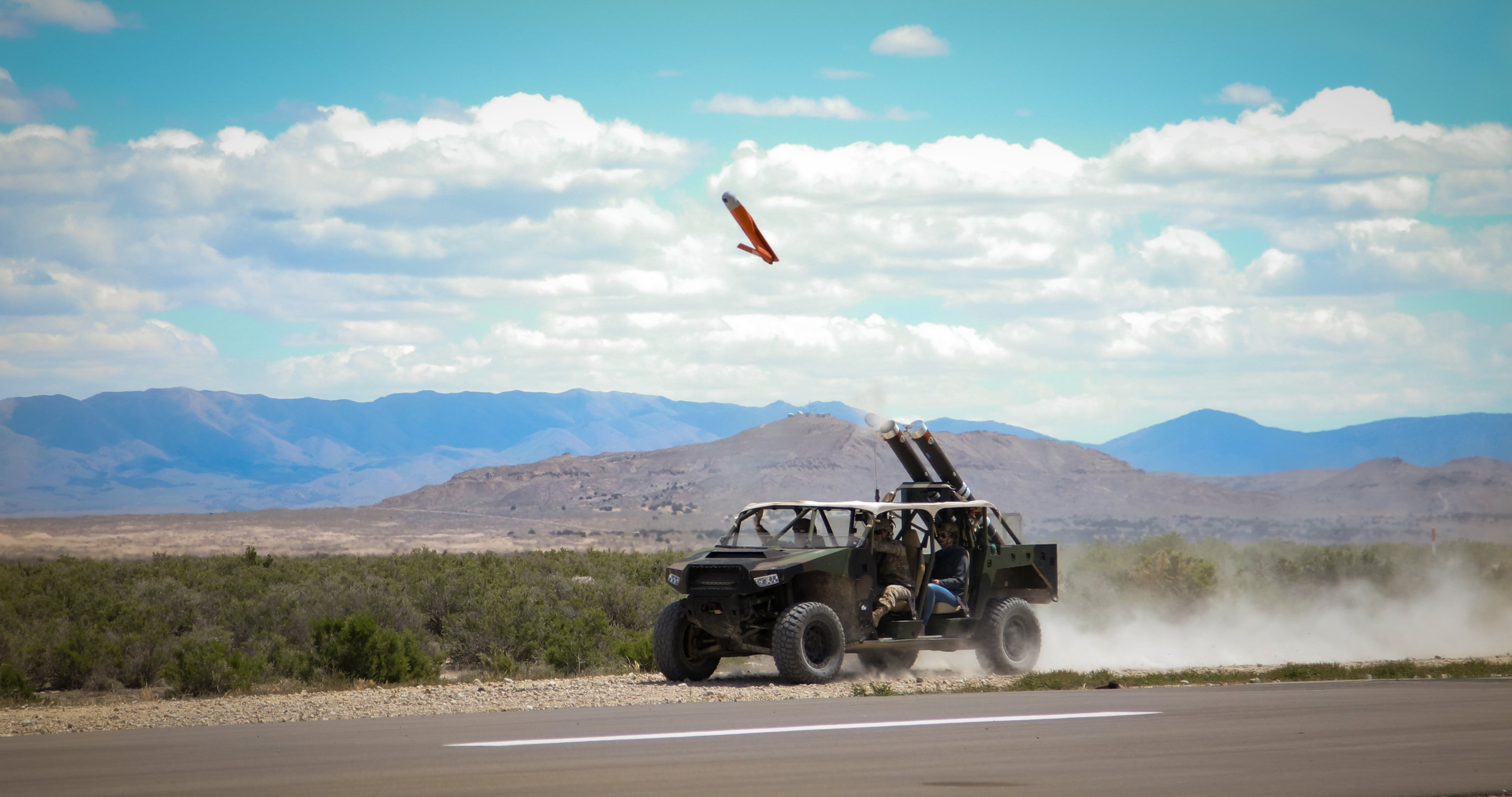DUGWAY PROVING GROUND, Utah — Aircrew in the back of a Black Hawk helicopter performing an air assault mission typically have limited information on the status and layout of a landing zone. But a two-weeklong exercise in the Utah desert gave those aboard three UH-60L helos unprecedented intelligence as they raced to their objective.
The crew at exercise Edge 21 received Integrated Visual Augmentation System, or IVAS, goggles as well as tablets that provided to-the-minute mission updates based on real-time intelligence collected from air-launched effects sensors.
In the past, “you got an update before you got on an aircraft and then flew for a half hour, 45 minutes, maybe an hour. Whatever it was, it was what it was when you got there,” Army Futures Command chief Gen. Mike Murray said of typical air assault operations. “The ability to understand what has changed since you got on an aircraft and to communicate amongst aircraft, among that squad or platoon — it’s an amazing change.”
And that was just one vignette from the intricate, aviation-focused exercise that will feed into a bigger campaign of learning this fall called Project Convergence.
There were many “firsts” at the exercise — 56 to be exact — as the Army brought together an operational unit from the 82nd Airborne Division and the science, technology and engineering community to see what might be in the realm of the possible as the service races to modernize.
Defense News was first to report the Army’s plans to hold the Experimental Demonstration Gateway Exercise, or Edge for short, at Dugway Proving Ground in Utah. Maj. Gen. Wally Rugen, who is in charge of the future vertical lift modernization effort, said in January that the new exercise will apply space, aviation and network capabilities to show how the Army and the joint force would fight in the Indo-Pacific theater based on high-fidelity modeling the service used to show the efficacy of its capabilities in the area of operation.
Edge 21 and Project Convergence will contribute to how the Army shapes its requirements for a future attack reconnaissance aircraft and a future long-range assault aircraft as well as a host of air-launched effects over the next decade.
RELATED
At Project Convergence, the US Army experienced success and failure — and it’s happy about both
“This is really the waypoint on the way to an aim point,” said Army Chief of Staff Gen. James McConville, with whom Defense News traveled to the exercise.
While future vertical lift is the focus of Edge, McConville said, the exercise addresses overall what the Army will need to fight effectively in the future. Critical to that, he added, is speed, range and the ability to converge capability to make quicker decisions than the enemy, “which gives us the overmatch we need.”
The Army needs “iterations and repetitions to get this right,” he explained. “A lot of concepts work very well when they’re PowerPoint slides; and what you need to do is you need to get them out in the dirt and get them out with soldiers.”
Seek and destroy
On the floor of a large hangar in the middle of the desert lays an enormous 3D map of a chain of islands in the Pacific Ocean. The map represents a challenging operational scenario for an exercise taking place in the surrounding skies and sagebrush-speckled terrain.
Outside, F-35B fighter jets rip across the sky, a new demonstrator jet collects intel and performs reconnaissance, and large air-launched effects drop from aircraft. Small drones are shot from the back of an all-terrain vehicle while on the move as a highly classified loitering munition simultaneously blows up targets and a soldier on an air assault mission takes control of a drone using a tablet after landing on the ground to check out a nearby blind spot.

Though the cardboard islands on the hanger floor bear made-up names, they harbor real threats representing a range of anticipated adversarial weapons systems designed to challenge U.S. Army capabilities envisioned for a fighting force in the 2030s that will operate across land, sea, air, cyberspace and space.
The geography of the Pacific Ocean is forcing the Army to find ways to overcome some of the most challenging operational distances in the world. The mission on May 14, the last day of the exercise, was meant to assess the service’s deep-fires capability to neutralize enemy weapon systems, radars and mission-command stations on enemy-occupied islands from a safe position out of range of the enemy. That capability in turn would provide a window of opportunity for an air assault mission to land on the islands and take control.
At the start of the demonstration, the Army used manned and unmanned aircraft to collect intelligence and identify possible targets. In the scenario, an intelligence, surveillance and reconnaissance jet demonstrator called Artemis spots three targets on an enemy-controlled island: an air defense radar, a ground-control station and a surface-to-air missile system (in this case, a Russian Pantsir).
A large air-launched effects, or ALE, capability is launched from a Gray Eagle drone to refine the targeting data and pass the information to the appropriate long-range shooters.
The ALE-Large is a system under development by the Pentagon’s Strategic Capabilities Office through a classified program. The ALE-L used at Dugway was built by L3Harris Technologies, is capable of flying at more than 200 knots and has a range of more than 300 kilometers. The system flew only one other time at Yuma, Arizona, in February.
Three classified, man-in-the-loop loitering munitions are deployed and simultaneously destroy the ground-control station and the radar, but the Pantsir remains untouched.
According to Rugen, it was determined the third munition, due to an undisclosed issue, would not have simultaneously hit its target and therefore the service decided to abort the mission to preserve the pricey asset for Project Convergence.
When targets were identified on a separate island, F-35Bs deployed to destroy those threats around the same time the long-range effects hit their targets.
The follow-up
To determine targets are neutralized to set the scene for an air assault mission, the Army deploys a small ALE with an electro-optical infrared sensor from a C-12 transport aircraft (one of the firsts), sent out at 18,000 feet from a launcher built into the wing locker.
Two other ALE-Small systems are shot from pneumatic tubes on an all-terrain vehicle belonging to the 82nd Airborne Division. Originally the ALE-S systems were to deploy from an F-150 truck, but when the 82nd arrived, the unit opted to try installing the capability in the back of its Polaris DAGOR vehicle. Over the course of 11 days, the unit managed to shoot ALE-S from the vehicle on the move (another first).
The ALE-S used in the exercise is the Altius tube-launched unmanned aircraft system, which was supplied for demonstrations over several years, beginning with initial experiments launching UAVs from helicopters.
A surrogate for the future attack reconnaissance aircraft — a UH-60 Alpha-model helicopter with experimental sensors and algorithms — also deploys to provide full-spectrum targeting throughout the exercise.

With three ALE-S systems in the air, data flows in small packages to the task force commander, who then identifies a possible threat to the north as three Black Hawks fly their route to the planned objective. The commander collaborates through the IVAS system with the different aircraft in flight, ultimately deciding to change his tactical plan.
As the Black Hawks approach the landing zone, a communication system gives the aircrew constant connectivity to sensors that see through the aircraft, providing soldiers a clear picture of the landing zone below.
Once on the ground, a soldier is able to take over one of the ALE-S systems using his tablet connected to the tactical, scalable MANET network in order to fly it over a blind spot on the other side of a mountain.
In unprecedented speed, the soldier learned how to control both the UAS and its sensors from a tablet in under an hour before executing the mission. At prior exercises, including last year’s Project Convergence, specialized units were the ones executing such missions.
Evolution of convergence
McConville likened Edge 21 to a scrimmage before the big game — Project Convergence. The tactics, techniques, procedures and technology integration at Edge 21 will give the Army tools to take its development to the next level.
Many of the same assets at Edge 21 will be at Project Convergence later this year, but payloads may be enhanced or changed. For instance, the ALE-L will get a synthetic aperture radar and an electronic warfare capability. At Edge, it was equipped with a communications system.

But it’s not just about the technology; each experiment gives the Army an opportunity to make technology simpler and more user friendly.
Maj. Gen. Christopher Donahue, the 82nd Airborne Division commander, said his unit loves that IVAS is already bringing disparate capabilities into one form factor, but he added there’s still work to do.
Another challenge, he noted, is bringing in such a wide variety of unique sensors. “We are really stressing our mission command systems, so I think coming out of this we will probably see a lot more work on mission command systems,” he said.
Like Edge 21, Project Convergence will involve real operational soldiers, which could produce new ideas on how to use technology. For perspective, Rugen said, the Army had a list of 35 “firsts” it wanted to achieve at Edge 21. With the 82nd Airborne involved, the service achieved far more.
“Having the soldiers here just added that octane,” Rugen said.
Refinement will continue on the Army’s modular, open-system architecture, he added, because the ability to plug a capability into an overall system is critical to driving down the decision-making timeline necessary to outpace the enemy.
“Everything that you are seeing here is what we would probably refer to as an ‘alpha’ model,” McConville said of the open-architecture capability at the exercise. “It’s the initial model, and we know that this is not going to be the final model.”
We’re going to continue to learn,” he added, “so as technology improves we can quickly upgrade it without taking the whole system apart.”
Efforts at Project Convergence are expected to speed up the delivery of data during battle. Army leaders continue to stress that the speed at which decisions can be made on the battlefield is the difference between winning and losing.
The Army has already made big leaps in how it will use its aerial assets in a fight. Just a year and a half ago, the service celebrated the ability of an operator with a tablet inside a helicopter to take control of a Gray Eagle drone, then task it with firing a munition.
Rugen said the Army continues to prove that the lower tier of the air domain brings a vital capability to the table because future vertical lift can be used to fight from “relative sanctuary” and provide operational effects. The service will continue to show new possibilities on that front, with Project Convergence being its next opportunity.
Jen Judson is an award-winning journalist covering land warfare for Defense News. She has also worked for Politico and Inside Defense. She holds a Master of Science degree in journalism from Boston University and a Bachelor of Arts degree from Kenyon College.




